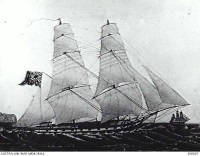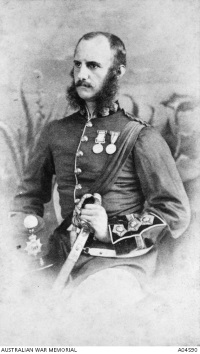British settlement of Australia began as a penal colony governed by a captain of the Royal Navy. Until the 1850s, when local forces began to be recruited, British regular troops garrisoned the colonies with little local assistance. From 1788 marines guarded English settlements at Sydney Cove and Norfolk Island; they were relieved in 1790 by a unit specifically recruited for colonial service, and in 1810 the 73rd Regiment of Foot became the first line regiment to serve in Australia.

Starboard side representation of the brig sloop HMS Pelorus, which was based at Sydney from 1838 to 1839
With the end of convict transportation to New South Wales in 1840, the need for military forces diminished and troop strength began to decline, particularly as British troops were required in the first Anglo–Maori wars in New Zealand and as colonial police forces were formed. After the last British regiment left in 1870 the colonies were obliged to assume responsibility for their own defence. Only rarely during their time in Australia did British troops fire upon fellow Europeans. In March 1804 British regulars suppressed a convict rebellion near Castle Hill, and in 1829 soldiers were involved in putting down the "Ribbon Gang" outbreak near Bathurst.
By 1863 hostilities had reignited, and New Zealand's colonial authorities requested further assistance from Australia. A contingent of British troops was dispatched, along with Her Majesty's Colonial Steam Sloop Victoria. In July 1863 British troops invaded the Waikato area and news of the continuing campaign spread through the Australian colonies.
Despite the preponderance of British troops in the Australian colonies, colonial military forces were maintained from as early as December 1788, when the commandant of Norfolk Island, Phillip Gidley King, ordered his free male settlers (numbering six) to practise musketry on Saturdays. The first military unit raised on the Australian mainland appeared in September 1800, when Governor Hunter asked 100 free male settlers in Sydney and Parramatta to form Loyal Associations (English volunteer units raised to put down civil unrest) and practice military drills in case the Irish convicts rebelled.

An officer of the 50th Regiment of Foot who was stationed at Victoria Barracks, Sydney, between 1866 to 1869, following service in the New Zealand wars. Insignia on cuff and collar indicates the rank of captain and the medals are for service in the Crimean War.
In 1899 trained citizen soldiers were given the opportunity to test their skills in the Boer War, to which the colonial governments, and later the Commonwealth, sent contingents. The administration of colonial military forces passed to the Commonwealth on 1 March 1901, following federation.
References
R. Broome, "The struggle for Australia: Aboriginal–European warfare, 1770–1930", in M. McKernan and M. Browne (eds), Australia: two centuries of war and peace, Canberra, Australian War Memorial and Allen and Unwin, 1988
P. Dennis, et al., The Oxford companion to Australian military history, Melbourne, Oxford University Press, 1995
Kit Denton, For Queen and Commonwealth: Australians at war, vol. 5, Sydney: Time-Life Books Australia, 1987
J. Grey, A military history of Australia, Melbourne, Cambridge University Press, 1990
H. Reynolds, The other side of the frontier: Aboriginal resistance to the European invasion of Australia, Ringwood, Vic., Penguin, 1982
P. Stanley, The remote garrison: the British army in Australia, 1788–1870, Kenthurst, NSW, Kangaroo Press, 1986
Craig Wilcox, For hearths and homes: citizen soldiering in Australia, 1854–1945, St Leonards, NSW, Allen and Unwin, 1998
Source: www.awm.gov.au/articles/atwar/colonial (accessed 13 June 2019)